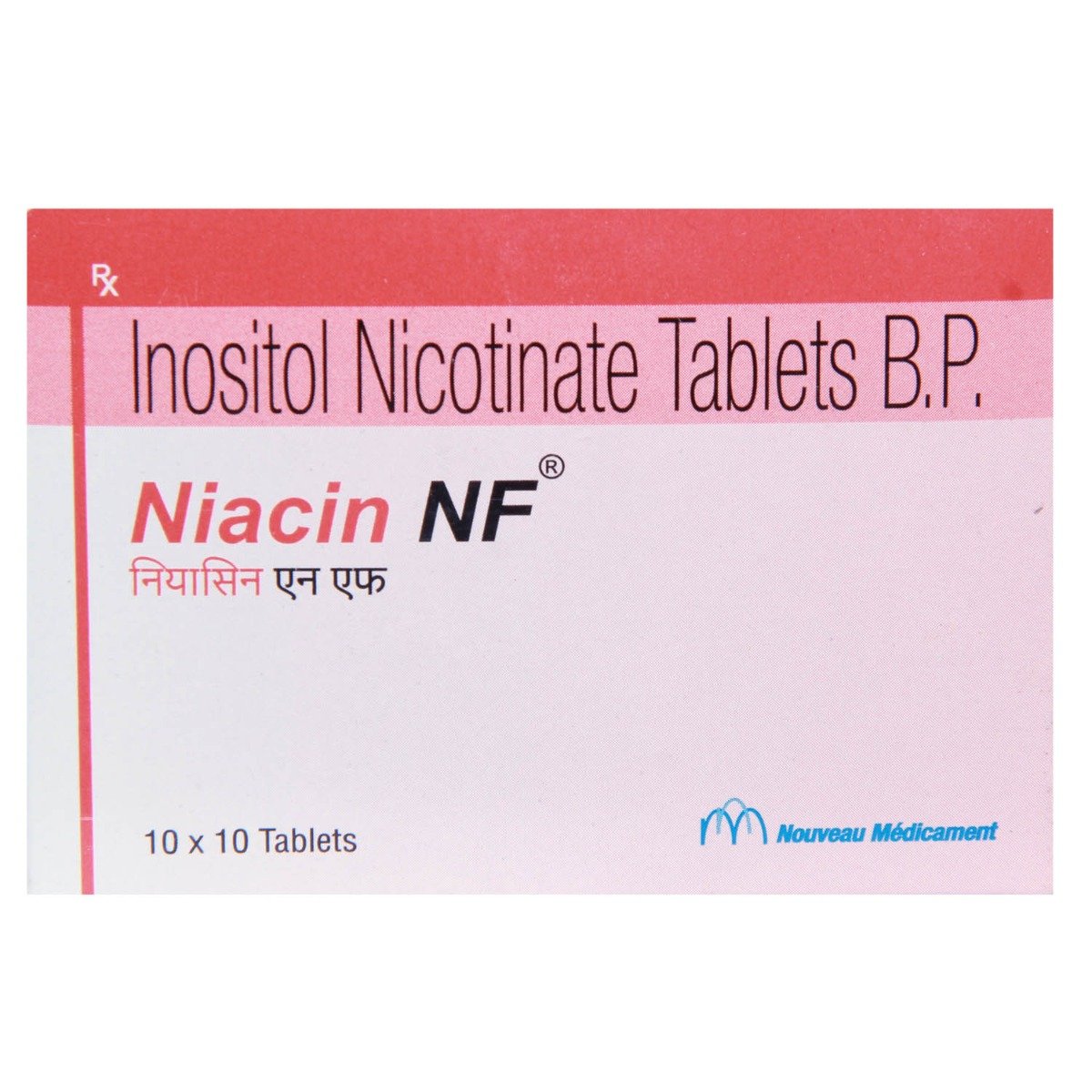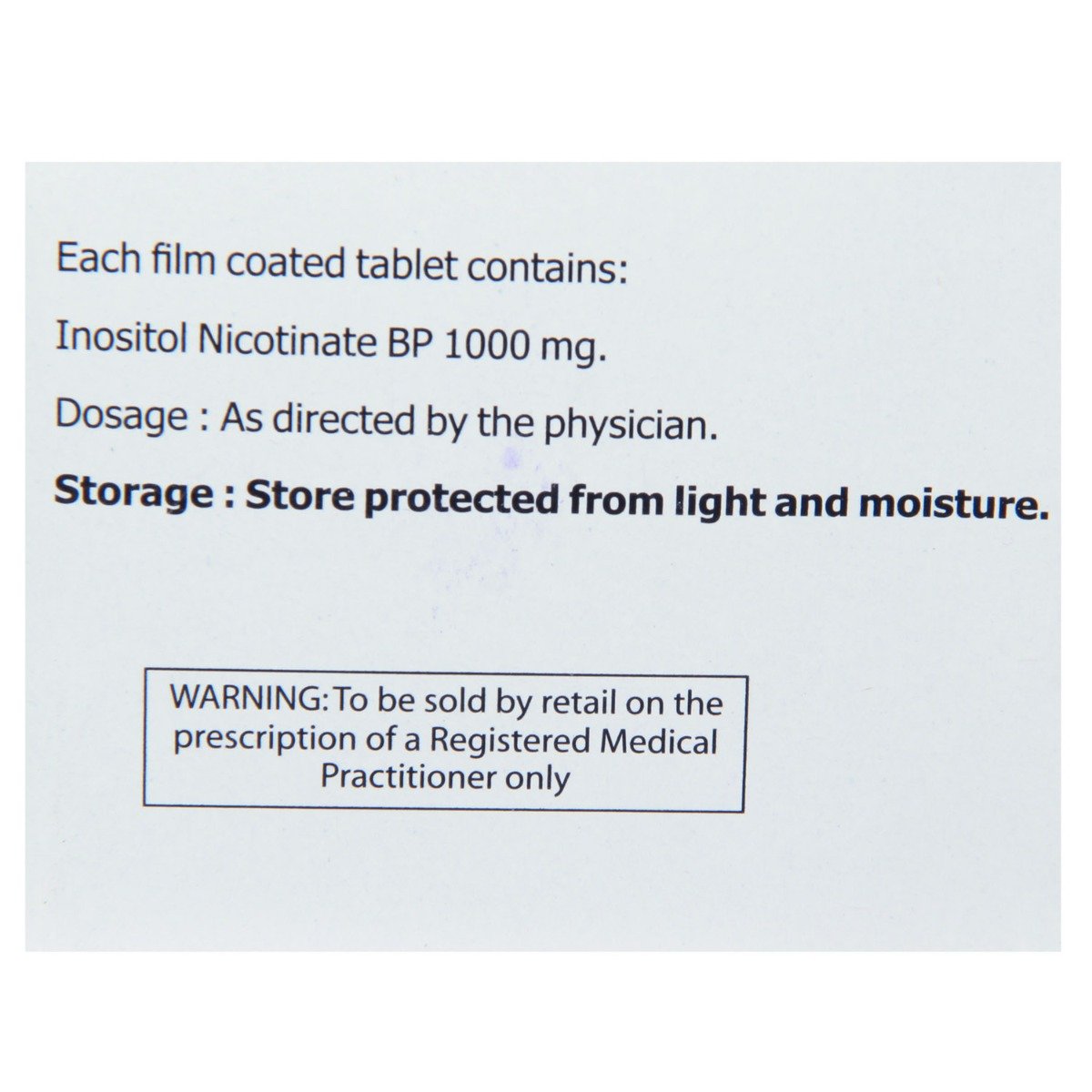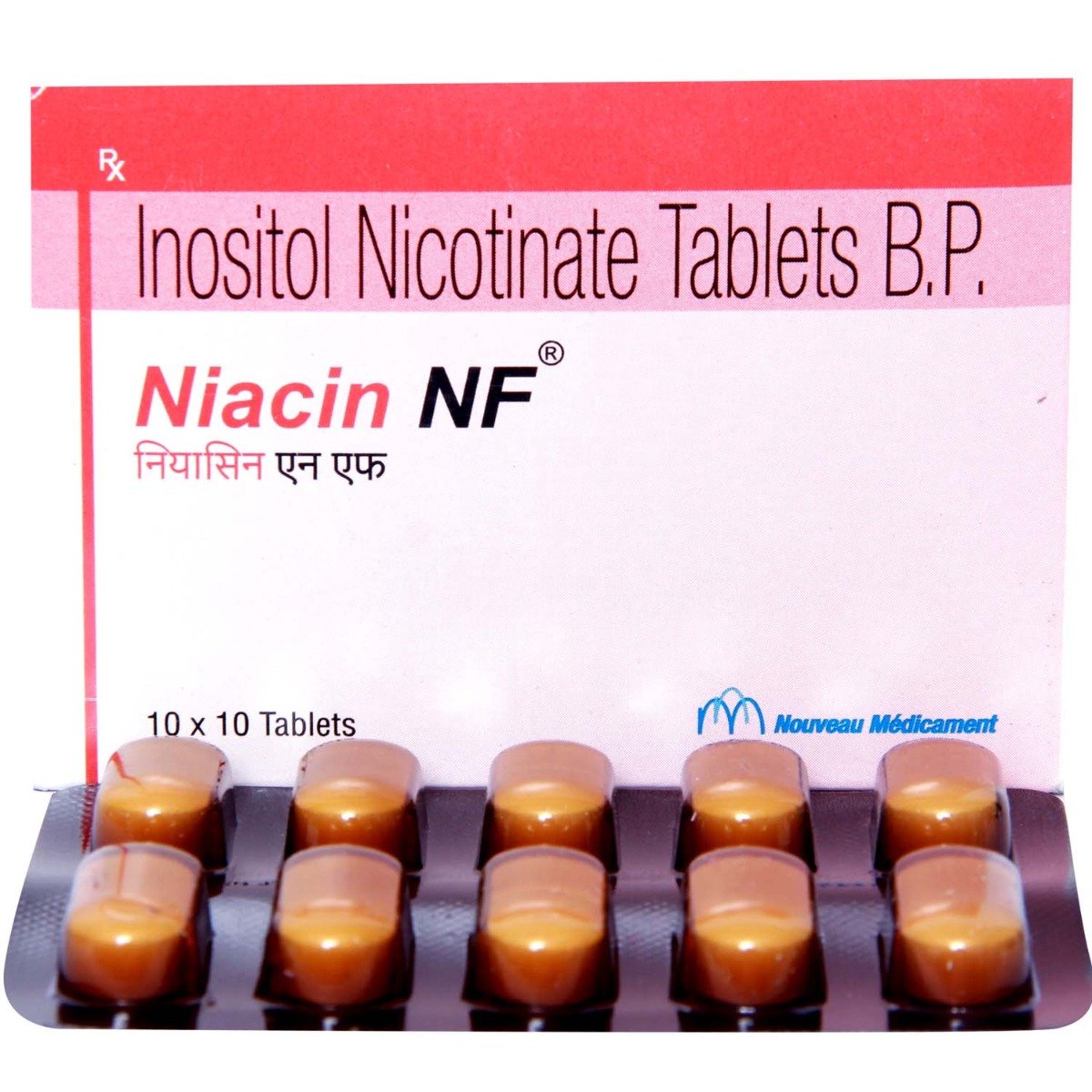Niacin NF Tablet 10's



MRP ₹100
(Inclusive of all Taxes)
₹15.0 Cashback (15%)
Know Your Delivery Time
Provide Delivery Location

Secure Payment

India's Most Trusted Pharmacy

Genuine Products
Composition :
Manufacturer/Marketer :
Consume Type :
Return Policy :
Expires on or after :
NPPA :
About Niacin NF Tablet
Niacin NF Tablet is indicated for managing peripheral vascular disease. Additionally, Niacin NF Tablet may also be used to treat intermittent claudication, stasis dermatitis, Raynaud’s disease and cerebral vascular disease. Peripheral vascular disease is a blood circulation disorder that causes the blood vessels outside the brain and heart to narrow and block. The narrowed blood vessels cause reduced blood flow.
Niacin NF Tablet contains ‘Inositol nicotinate’ that dilates the blood vessels and improves blood circulation by releasing histamine and breaking up the protein required for blood clotting. Niacin NF Tablet lowers the cholesterol and triglyceride levels, thereby preventing the formation of lipids.
You are advised to take Niacin NF Tablet for as long as your doctor has prescribed it for you, depending on your medical condition. In some cases, you may experience certain common side effects, such as nausea, vomiting, diarrhoea, stomach upset, and flatulence. Most of these side effects do not require medical attention and will resolve gradually over time. However, you are advised to talk to your doctor if you experience these side effects persistently.
Consult your doctor if you are pregnant or breastfeeding. Niacin NF Tablet may cause dizziness, so drive only if you are alert. Niacin NF Tablet should be given to children only if prescribed by the doctor. Avoid consuming alcohol with Niacin NF Tablet as it could lead to increased dizziness and liver problems. Keep your doctor informed about your health condition and medicines to rule out any side effects/interactions.
Uses of Niacin NF Tablet
Niacin NF Tablet is used in the management of peripheral vascular disease. The detailed uses of Niacin NF Tablet are as follows:
- Manages Peripheral Vascular Disease (PVD): Niacin NF Tablet helps treat PVD by widening blood vessels, breaking down proteins involved in blood clotting, and improving blood flow to the limbs.
- Treats Intermittent Claudication: Niacin NF Tablet relieves muscle pain or cramps in the legs caused by inadequate blood flow during exercise.
- Manages Stasis Dermatitis: Niacin NF Tablet improves blood flow in the lower legs, helping to manage skin inflammation and discolouration caused by poor circulation in stasis dermatitis.
- Relieves Raynaud's Phenomenon: Niacin NF Tablet helps reduce the frequency and severity of Raynaud's attacks by promoting better blood flow to the toes and fingers.
- Treats Cerebral Vascular Disease: Niacin NF Tablet may be used to improve blood flow in the brain, helping to manage symtpoms related to conditions that affect cerebral blood vessels.
Health Queries
500 mg priceEny side effectBefore and after eating
Dr Bayyarapu Kumar
M Pharmacy

Have a query?
Directions for Use
- Niacin NF Tablet can be taken with a meal or as prescribed by the doctor.
- Follow your doctor's instructions on the dosage and timing of this medication to ensure safety.
- Swallow Niacin NF Tablet as a whole with a glass of water.
- Do not chew, crush, or break it.
Medicinal Benefits
Niacin NF Tablet belongs to a group of medicines called vasodilators indicated for the management of peripheral vascular disease. Niacin NF Tablet dilates the blood vessels and improves blood circulation by releasing histamine and breaks-up the protein required for blood clotting. Niacin NF Tablet lowers the cholesterol and triglyceride levels, thereby preventing the formation of lipids. Niacin NF Tablet may also be used to treat intermittent claudication, stasis dermatitis, Raynaud’s disease, and cerebral vascular disease.
How Niacin NF Tablet Works
Storage
What if I have taken an overdose of Niacin NF Tablet
Drug Warnings
Do not take Niacin NF Tablet if you are allergic to any of its components. Inform your doctor if you have a bleeding disorder, diabetes, high blood pressure, heart disease, gall bladder disease, gout, low blood pressure, stomach ulcers, liver or kidney problems. Consult your doctor if you are pregnant or breastfeeding. Niacin NF Tablet may cause dizziness, so drive only if you are alert. Niacin NF Tablet should be given to children only if prescribed by the doctor. Avoid consuming alcohol with Niacin NF Tablet as it could lead to increased dizziness and liver problems.
Drug-Drug Interactions
Drug-Drug Interactions
Login/Sign Up
Drug-Food Interactions
Drug-Food Interactions
Login/Sign Up
Diet & Lifestyle Advise
Exercising regularly helps in improving overall health. Take a break between exercises if you feel uneasy. Finding the right exercise is the key.
Rest well, get plenty of sleep.
Take proper care of your legs and feet.
Wear shoes that fit you well.
Check your feet daily for any cracks or sores.
Try to stay warm. Avoid cold temperatures.
Avoid smoking and alcohol consumption.
Meditation and yoga can help lower stress, decrease pain sensitivity and improves coping skills.
Acupuncture can be helpful by stimulating pressure points.
Using essential oils for massages can help increase circulation.
Habit Forming
Therapeutic Class
All Substitutes & Brand Comparisons
RX
Out of StockHexolip 1000Mg Tablet
J B Chemicals & Pharmaceuticals Ltd
₹115
(₹10.35 per unit)
14% COSTLIER
Alcohol
Unsafe
Avoid consumption of alcohol while taking Niacin NF Tablet as it may cause increased dizziness.
Pregnancy
Caution
Please consult your doctor if you have any concerns regarding this; your doctor will prescribe only if the benefits outweigh the risks.
Breast Feeding
Caution
Consult your doctor before taking Niacin NF Tablet ; your doctor will decide whether Niacin NF Tablet can be taken by breastfeeding mothers or not.
Driving
Caution
Niacin NF Tablet may cause dizziness. Do not drive or operate machinery unless you are alert.
Liver
Unsafe
Niacin NF Tablet should not be used in patients with liver disease. Please consult your doctor if you have a liver impairment or any concerns regarding this.
Kidney
Unsafe
Niacin NF Tablet should not be used in patients with kidney disease. Please consult your doctor if you have kidney impairment or any concerns regarding this.
Children
Caution
Niacin NF Tablet should not be given to children unless prescribed by the doctor.
Heart
Niacin NF Tablet should be taken with caution in patients with heart problems. Please inform your doctor if you have any pre-existing heart problems before using Niacin NF Tablet .
Geriatrics
Caution
Niacin NF Tablet should be given with caution in elderly patients due to an increased risk of side effects. If you have any concerns about the usage of Niacin NF Tablet in geriatrics, please consult your doctor.
FAQs
Niacin NF Tablet is used to manage peripheral vascular disease. Additionally, it may also be used to treat intermittent claudication, stasis dermatitis, Raynaud’s disease and cerebral vascular disease.
Niacin NF Tablet dilates the blood vessels and improves blood circulation by releasing histamine and breaks-up the protein required for blood clotting. Niacin NF Tablet lowers the cholesterol and triglyceride levels, thereby preventing the formation of lipids.
Niacin NF Tablet might interfere with blood sugar control, thereby affecting blood glucose levels. Inform your doctor if you are diabetic; your doctor may adjust the dose accordingly. Regularly monitor blood sugar levels while taking Niacin NF Tablet .
Do not discontinue Niacin NF Tablet without consulting your doctor. To treat your condition effectually, continue taking Niacin NF Tablet for as long as prescribed. Do not be reluctant to speak with your doctor if you feel any difficulty while taking Niacin NF Tablet .
Consult your doctor before taking Niacin NF Tablet with anti-hypertensive medicines. Niacin NF Tablet might lower the blood pressure; therefore, use Niacin NF Tablet with caution if you are taking anti-hypertensive medicines. Together, they might lower blood pressure than normal. Regularly monitor blood pressure levels while taking Niacin NF Tablet .
Please consult your doctor before taking Niacin NF Tablet with statins (lipid-lowering agents) because when taken together, rhabdomyolysis (severe muscle problem) might occur.
Niacin NF Tablet should not be taken if you have peptic ulcer disease. Niacin NF Tablet breaks down in the body to release niacin which may affect the peptic ulcers. Please consult your doctor if you have any concerns regarding this.
Niacin NF Tablet might slow down the blood clotting, thereby increasing the risk of bleeding and might make bleeding disorders worse. Be cautious while using sharp objects, and consult a doctor immediately if you notice bleeding for a longer time.
Niacin NF Tablet can increase the risk of irregular heartbeat; therefore, inform your doctor before taking Niacin NF Tablet if you have heart disease such as unstable angina. Regular monitoring of heart rate is advised.
Yes, Niacin NF Tablet is effective if taken as advised by the doctor for the prescribed duration.
Niacin NF Tablet should be swallowed as a whole with water; do not crush or chew it.
Niacin NF Tablet may cause side effects such as nausea, vomiting, diarrhoea, stomach upset, and flatulence. Most of these side effects do not require medical attention and will resolve gradually over time. However, you are advised to talk to your doctor if you experience these side effects persistently.
Country of origin
Manufacturer/Marketer address
Disclaimer
Author Details
We provide you with authentic, trustworthy and relevant information
Buy best Vascular System products by
Emcure Pharmaceuticals Ltd
Intas Pharmaceuticals Ltd
Leeford Healthcare Ltd
Ozone Pharmaceuticals Ltd
Sun Pharmaceutical Industries Ltd
Cipla Ltd
Lupin Ltd
Macleods Pharmaceuticals Ltd
Torrent Pharmaceuticals Ltd
Mercury Laboratories Ltd
Abbott India Ltd
Akumentis Healthcare Ltd
FDC Ltd
Samarth Life Sciences Pvt Ltd
Walter Bushnell
Dr Reddy's Laboratories Ltd
Grifols India Healthcare Pvt Ltd
Indoco Remedies Ltd
Mankind Pharma Pvt Ltd
Morepen Laboratories Ltd
Oaknet Healthcare Pvt Ltd
Reliance Formulation Pvt Ltd
Wanbury Ltd
Alembic Pharmaceuticals Ltd
East West Pharma India Pvt Ltd
Galcare Pharmaceuticals Pvt Ltd
Juggat Pharma Ltd
Kee Pharma Ltd
Knoll Pharmaceuticals Ltd
Kontest Pharmaceuticals
La Pristine Bioceuticals Pvt Ltd
Pfizer Ltd
Prevego Healthcare & Research Pvt Ltd
Saf Fermion Ltd
Serdia Pharmaceuticals India Pvt Ltd
Systopic Laboratories Pvt Ltd
Theia Health Care Pvt Ltd
Themis Chemicals Ltd
Themis Medicare Ltd
Aarux Pharmaceuticals Pvt Ltd
Akcent Healthcare India Pvt Ltd
Amelia Healthcare Pvt Ltd
Bharat Serums and Vaccines Ltd
Canixa Life Sciences Pvt Ltd
Capital Pharma
Chemo Healthcare Pvt Ltd
Elbrit Life Sciences Pvt Ltd
Eris Life Sciences Ltd
Eysys Pharmaceutical Pvt Ltd
German Remedies Ltd
Glenmark Pharmaceuticals Ltd
Ipca Laboratories Ltd
Johnlee Pharmaceuticals Pvt Ltd
Nexgen Rx Life Science Pvt Ltd
Rapross Pharmaceuticals Pvt Ltd
Rockmed Pharma Pvt Ltd
Sterkem Pharma Pvt Ltd
Sumac Pharma Pvt Ltd
Themis Pharmaceutical Ltd
4Care Lifesciences Pvt Ltd
Aar Ess Remedies Pvt Ltd
Albert David Ltd
Alna Biotech Pvt Ltd
Aphia Healthcare
Apios Lifesciences Pvt Ltd
Aristo Pharmaceuticals Pvt Ltd
BSA Pharma Inc
Baxter India Pvt Ltd
Bennet Pharmaceuticals Ltd
Biosys Pharmaceuticals Ltd
Bros Enterprises Ltd
Cadila Pharmaceuticals Ltd
Calren Care Lifesciences Pvt Ltd
Celebrity Biopharma Ltd
Cibeles Pharmaceuticals Pvt Ltd
Comed Chemicals Ltd
Conatus Healthcare Pvt Ltd
Cresha Lifesciences
Cute Care Life Sciences Pvt Ltd
Cytogenix Pharmaceuticals Pvt Ltd
Dermacia Healthcare
Ethinext Pharma
Euro Biogenics
Fling Pharmaceuticals Pvt ltd
Genees Pharmaceutical Pvt Ltd
Icon Life Sciences
J B Chemicals & Pharmaceuticals Ltd
Kemiq Lifesciences Pvt Ltd
Kivi Labs Ltd
Knoll Healthcare Pvt Ltd
Lincoln Pharmaceuticals Ltd
Medchronic Health Care
Medgen Drugs And Laboratories Pvt Ltd
Medishri Healthcare Pvt Ltd
Megma Healthcare Pvt Ltd
Neocardiab Care
Novartis India Ltd
Novo Nordisk India Pvt Ltd
Olcare Laboratories Pvt Ltd
Ornate Labs Pvt Ltd






